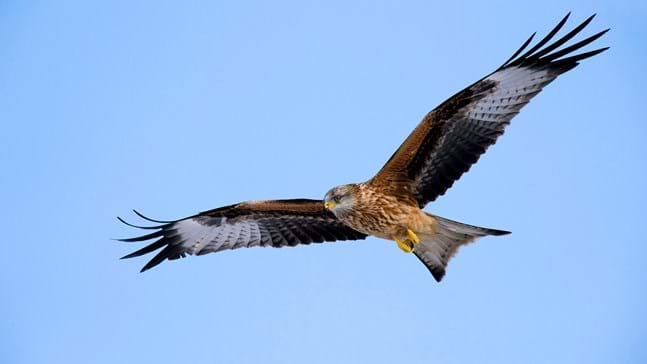
Credit: Our Wild Life Photography / Alamy Stock Photo
What do red kites eat?
The red kite is a scavenger and eats mostly carrion, road kill and worms. If necessary, it will sometimes catch small, live prey such as voles, mice and birds.
A majestic scavenger, the red kite searches for food in almost any environment, then returns to nest in broadleaved woodland. Look out for them wheeling high in the air, or nesting up in the canopy.
Common name: red kite
Scientific name: Milvus milvus
Family: Accipitridae (hawks and eagles)
Habitat: grassland, woodland, heathland, urban areas
Diet: scavenged carrion, small mammals, invertebrates
Predators: none
Origin: native
Red kites have a rusty reddish-brown body with a deeply forked tail. Their head is pale grey and patterned with dark streaks, and they have a yellow beak with a dark hook and pale, striking eyes.
Their angular wings span 185cm. On the upper side they are red-brown at the shoulders with darker tips and edges, while underneath there are characteristic blocks of white before darker, fingered wing tips.

Credit: Our Wild Life Photography / Alamy Stock Photo
The red kite is a scavenger and eats mostly carrion, road kill and worms. If necessary, it will sometimes catch small, live prey such as voles, mice and birds.
The red kite is attracted to shiny and colourful objects, often incorporating them into their nests.
Red kites first breed at two years old and produce a single clutch of around three eggs. As monogamous birds, mating pairs will return to the same nests each season, adding new material to them during the breeding period.
The female stays with the eggs while the male sources her food. When the eggs hatch, chicks stay in the nest until they fledge at around 60 days old. They will then continue to be fed by their parents for a few weeks.

Credit: Oliver Smart / Alamy Stock Photo
Red kites nest in broadleaved woodland. They search for food in wooded valleys, pasture and open countryside as well as in suburban areas and towns.
Red kites were common in medieval London. The bird was even referenced several times in Shakespeare’s plays.
Once confined only to Wales, the red kite is slowly returning to other parts of the UK. They are now easily spotted in the Chilterns and central Scotland, and are spreading across much of southern England.
Red kites can be seen all year round and are active during the day. Look for them soaring on warm, sunny days when their distinctive forked tail and wheeling flight is on show.
Audio: Nils Agster / xeno-canto.org

Credit: Calum Dickson / Alamy Stock Photo
Red kites were almost wiped out in the UK due to persecution, and by the early 20th century only a few breeding pairs remained in Wales. Re-introductions have since expanded the bird’s range and their population is beginning to recover.
The red kite was once a common bird in towns and cities where it scavenged for scraps. It was a crime to kill one as they were so useful for rubbish management.

Amy Lewis • 10 Sep 2021
Learn how to identify the UK's birds of prey with our quick guide to their calls, key features and likely hangouts.
Identify birds of prey